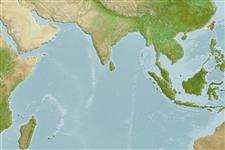Common names from other countries
Klassifizierung / Names
Namen | Synonyme | Catalog of Fishes(Gattung, Arten) | ITIS | CoL | WoRMS | Cloffa
>
Blenniiformes (Blennies) >
Tripterygiidae (Triplefin blennies) > Tripterygiinae
Etymology: Enneapterygius: Greek, ennea = nine times + Greek, pterygion = little fin (Ref. 45335).
Environment: milieu / climate zone / depth range / distribution range
Ökologie
seewasser demersal; tiefenbereich 1 - 6 m (Ref. 79877). Subtropical
Northwest Pacific: Taiwan.
Size / Gewicht / Alter
Maturity: Lm ? range ? - ? cm
Max length : 3.0 cm SL Männchen/unbestimmt; (Ref. 79877)
Kurzbeschreibung
Bestimmungsschlüssel | Morphologie | Morphometrie
Rückenflossenstacheln (insgesamt) : 17; Rückenflossenweichstrahlen (insgesamt) : 10; Afterflossenstacheln: 1; Afterflossenweichstrahlen: 19 - 20. This species is distinguished by having the following characters: D III, XIV, 10, with first dorsal fin lower than second dorsal fin; A I,19-20; pored lateral line scales 18-20, notched scales 17-19; mandibular pore pattern 3+1+3; supraorbital and nasal cirrus slender and long; body color pale or light yellowish with 4 brownish-yellow or reddish-brown bars below second and third dorsal fins and caudal peduncle; behind base of pectoral fin is a brownish-black or black saddle mark; head pale with scattered melanophores, with some males densely spotted resembling a black mask on overall head; dorsal fins reddish to orange with second dorsal membrane dusky near the base; other fins are pale yellow to yellow; supraoccipital sensory canal forms a flattened curve anterior to first dorsal fin (Ref. 79877).
Eggs are hemispherical and covered with numerous sticky threads that anchor them in the algae on the nesting sites (Ref. 240). Larvae are planktonic which occur primarily in shallow, nearshore waters (Ref. 94114).
Life cycle and mating behavior
Maturities | Fortpflanzung | Spawnings | Egg(s) | Fecundities | Larven
Chiang, M.-C. and I.-S. Chen, 2008. Taxonomic review and molecular phylogeny of the triplefin genus Enneapterygius (Teleostei: tripterygiidae) from Taiwan, with descriptions of two new species. The Raffles Bull. Zool. 19:183-201. (Ref. 79877)
IUCN Rote Liste Status (Ref. 130435)
CITES (Ref. 128078)
Not Evaluated
Bedrohung für Menschen
Harmless
Nutzung durch Menschen
Tools
Zusatzinformationen
Download XML
Internet Quellen
Estimates based on models
Phylogenetic diversity index (Ref.
82804): PD
50 = 0.5000 [Uniqueness, from 0.5 = low to 2.0 = high].
Bayesian length-weight: a=0.01000 (0.00244 - 0.04107), b=3.04 (2.81 - 3.27), in cm Total Length, based on all LWR estimates for this body shape (Ref.
93245).
Trophic level (Ref.
69278): 3.1 ±0.3 se; based on size and trophs of closest relatives
Widerstandsfähigkeit (Ref.
120179): hoch, Verdopplung der Population dauert weniger als 15 Monate. (Preliminary K or Fecundity.).
Fishing Vulnerability (Ref.
59153): Low vulnerability (10 of 100).
